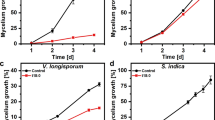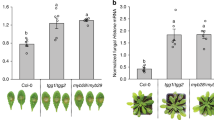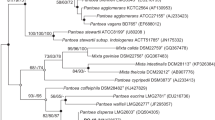Abstract
A SUBSTANCE present in oat roots and leaves which inhibits growth and respiration of several fungi has been described1. It was suggested that the resistance of oats to Ophiobolus graminis, the cause of take-all of wheat, and its susceptibility to the very similar O. graminis var. avenae, was connected with this inhibitor, since var. avenae (O isolates) grew in sap expressed from oat roots whereas O. graminis itself (W isolates) did not. However, crudely purified inhibitor seemed equally toxic to both. This inhibitor has now been purified by H. K. Mitchell and J. V. Maizel and named ‘avenacin’ (personal communication). They find it to be identical with a fluorescent glucoside described as occurring in oat root meristems by Goodwin2. They give the ED 50 against Neurospora crassa growing in Fries medium as 0.4 µgm./ml. They find that on hydrolysis in 0.1 N hydrochloric acid, it loses its biological activity, and glucose and an unidentified pentose are released (Maizel, J. V., and Mitchell, H. K., unpublished work).
This is a preview of subscription content, access via your institution
Access options
Subscribe to this journal
Receive 51 print issues and online access
$199.00 per year
only $3.90 per issue
Buy this article
- Purchase on Springer Link
- Instant access to full article PDF
Prices may be subject to local taxes which are calculated during checkout
Similar content being viewed by others
References
Turner, E. M., J. Exp. Bot., 7, 80 (1956).
Goodwin, R. H., and Kavanagh, F., Bull. Torrey Bot. Club 75, 1 (1948).
Jermyn, M. A., Aust. J. Biol. Sci., 12, 213 (1959).
Garrett, S. D., and Dennis, R. W. G., Trans. Brit. Mycol. Soc., 26, 146 (1943).
Turner, E. M., J. Gen. Microbiol., 16, 531 (1957).
Hestrin, S., Feingold, D. S., and Schramm, M., “Methods in Enzymology”, 1, 240 (1955).
Author information
Authors and Affiliations
Rights and permissions
About this article
Cite this article
TURNER, E. An Enzymic Basis for Pathogenic Specificity. Nature 186, 325–326 (1960). https://doi.org/10.1038/186325a0
Issue Date:
DOI: https://doi.org/10.1038/186325a0
This article is cited by
-
Physiology of resistance to fungal diseases in plants
The Botanical Review (1966)
Comments
By submitting a comment you agree to abide by our Terms and Community Guidelines. If you find something abusive or that does not comply with our terms or guidelines please flag it as inappropriate.



